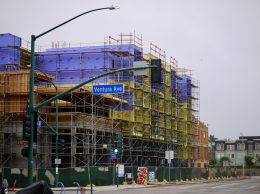In Star Wars creator’s building struggle, a new hope for housing
 Chris Thornberg and George Lucas are not usually found in the same room — let alone the same sentence.
Chris Thornberg and George Lucas are not usually found in the same room — let alone the same sentence.
But there they are: The founding partner of Beacon Economics and the legendary film director, gazillionaire and creator of the Star Wars and Indiana Jones mega-franchises.
And from the two of them, in recent days, a call for California’s exclusive coastal communities to kick out the jams just a little bit and build more housing.
In the case of Lucas, the plea comes in the form of a plan to build hundreds of units of affordable housing on the site of a dairy farm that was going to be his film studio — until county planners nixed that idea.
As reported in the Los Angeles Times on April 1, protesters on behalf of the project put something in print that I’ve only hinted at over the years — the way planning and zoning are used to discriminate against the rising tide of Latino schoolteachers, cops and firefighters who are effectively priced out of the housing market.
The Times recounts that “protesters wearing ‘End Apartheid in Marin County’ buttons demanded that officials do something to help low-income workers find housing in a place where the median home price is $650,000 and 60 percent of the workforce lives somewhere else.” Does that sound familiar?
Lucas, who ironically plunked down more than $30 million for a seaside home in Carpinteria last year, has teamed up with the Marin Community Foundation, which wants to improve air quality and the quality of life for the local workforce. Their partnership is the driving force behind the affordable housing project, which would cut greenhouse gas emissions by taking cars off of a chunk of Highway 101 in northern California.
And speaking to a group at a City National Bank annual forecast on March 28, Thornberg made a plea for a phased-in plan to increase housing stock along the Central Coast. He described a cascade of fiscal impacts that are the result of poor housing policies of the past few decades.
What’s driving California’s local governments to the poorhouse are the higher-than-average wages and pensions paid to public servants. What’s forcing higher wages for civil servants is higher home prices—even in the wake of the great recession, California’s average home price on the Central Coast is far higher than it is in Austin, Texas, where the median is something like $203,100 and the economy featurees a similar mix of technoloy, higher education and government jobs.
And in order to pay public sector employees more and more, taxes are going up, further driving out the middle class and putting a squeeze on all but the very wealthiest citizens.
In the world according to Thornberg, the balance can only be restored when housing supply increases and prices come down or stay down. That way, middle-class and professional families will be able to live closer to their work, pressure on pay will come down and taxes can be used for infrastructure improvements or to clean up the water supply or back fill pension obligations.
As a side effect, reduced commuting will make the air cleaner and relieve congestion on the highway.
From Marin County, a place with policies not unlike environmentally friendly San Luis Obispo, Santa Barbara or Ventura counties, comes a plea by George Lucas to make his region’s economy more sustainable and more diverse by building a large affordable housing project.
From Ventura County comes a plea by Chris Thornberg to drop the pretense that taxes can go up without limits and permit more housing to take the pressure off of local budgets — and as a byproduct, restore the idea of a middle-class family to the community makeup.
These are two of the smartest people in the room. Unfortunately, the rest of the room doesn’t seem to be listening.
• Contact Editor Henry Dubroff at [email protected].










